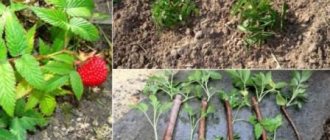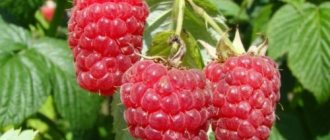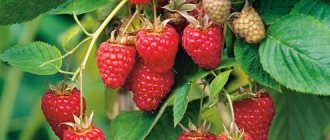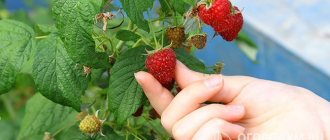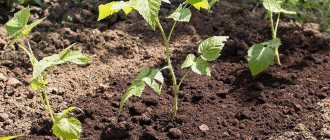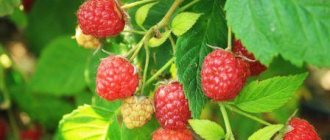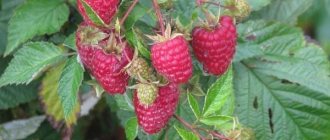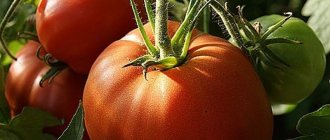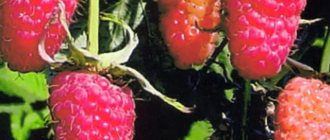Remontant raspberries have a number of very attractive properties, but, nevertheless, they are not suitable for all growing conditions and, in many respects, are not able to compete with modern “traditional” varieties. Proof of this can be the widely advertised raspberry “Monomakh’s Cap”, reviews of which are very mixed.
Advertising descriptions of the remontant large-fruited raspberry Monomakh's Cap (pictured) are of great interest to many gardeners, but reviews about it are very contradictory
First, let's look at the main characteristics of this variety:
| Parameter | Characteristic |
| Culture | Garden raspberry (Rubus idaeus L.) |
| Ripening time | Mid-late |
| Type of fruiting | Remontant |
| Productivity | High: up to 5 kg per bush |
| Berries | Large: weight on average 8-10 g (maximum up to 15-18 g), from dark purple to dark burgundy color, blunt-conical shape, juicy, dense |
| Taste qualities | Sweet and sour, aromatic |
| Purpose | Universal |
| Features of the plant | The bushes are medium-sized (up to 150 cm) with thick, strong stems (4-5 pieces). Thorns are few, large, located in the lower part of the shoots |
| Shoot formation activity | Low |
| Sustainability | Winter hardiness is average; the variety is susceptible to viral diseases of the crop |
| Registration in the Federal State Budgetary Institution "State Varietation Commission" | Turned off |
The history of mass cultivation of remontant raspberries in Russia goes back a little over 30 years. Until 1995, only varieties of foreign selection were available on domestic plots, which, as a rule, were not very suitable for our climatic conditions and were considered rather as exotics.
Remontant varieties of raspberries relatively recently appeared on the plots of Russian summer residents and for many have become a replacement for traditional varieties
Perhaps this circumstance became the reason for the rather strange attitude towards such varieties that many summer residents have formed. For example, there is a widespread belief that remontant raspberries are “better than traditional ones in everything.” Based on this, some gardeners have decided to completely abandon plants that bear fruit exclusively on last year’s shoots.
Description of raspberry Monomakh's Cap
Among the remontant raspberry varieties, the Monomakh Cap, bred by the Russian breeder I.V. Kazakov, is especially popular. Although this variety appeared quite recently, it has already won many fans.
Externally, raspberries look more like a tree. Its stems are quite powerful and grow up to one and a half meters high.
The fruits are purple in color and very large in size. They usually weigh 6-7 grams, but with ideal care they can reach 15-20 grams (equal in size to a small plum). Usually 4-5 kilograms of tasty berries are harvested from one bush, but under favorable conditions the yield increases to 6-8 kilograms.
The berries have an elongated, blunt-conical shape and dense pulp. They are easily separated from the stalk. They are characterized by a sweet taste with noticeable sourness. They leave a pleasant aftertaste. They have a well-defined raspberry aroma. Thanks to their elastic texture, Monomakh Cap fruits last longer than other varieties.
The first harvest is harvested in July from last year's shoots, and the second ripens from August to November on young stems, until the first frost. The autumn harvest is twice as large as the spring harvest and is not affected by pests.
There are almost no thorns on the shoots. In addition, they are mainly located at the bottom, which makes picking berries convenient.
This variety is quite frost-resistant. It can withstand 25° frost without problems. But in areas where the winter is too harsh, it is recommended to bend the shoots to the ground and cover them with snow.
Characteristics of the variety
In terms of external features, Monomakh's Cap looks more like a small tree than a bush: sometimes it is called that - a raspberry tree. The shrub is characterized by strong branched branches (as a rule, there are no more than 5 of them), reaching a height of 1.5 m. Shoots with bright green, medium-sized leaves, slightly drooping.
The large beautiful fruits of bright red-ruby color give particular value to the variety. The elongated berries have a blunt conical shape. The pulp has a dense and elastic structure and is easily separated from the stalk. The taste is sweet with pleasant sourness. The fruits are suitable for fresh consumption, making compotes and jams, as an additive to pies, dumplings and desserts.
The benefits and harms of lemon juice. Lemon juice on an empty stomach
Advantages and disadvantages
- Positive features of the variety:
- long (double) fruiting period, rich harvest;
- high resistance to low temperatures;
- good level of shelf life and transportation of dense berries;
- large fruit size, pleasant taste.
- Cons of Monomakh's Cap:
- low degree and quality of ripening in the case of cool summers;
- low sugar content and wateriness of berries due to lack of sunlight;
- sensitivity to soil acidity indicators;
- late second fruiting (in comparison with other remontant raspberry varieties);
- inability to fully harvest the second harvest due to rains and unfavorable weather conditions in case of late fruiting;
- low immunity to disease.
Drought resistance, frost resistance
Monomakh's cap is not drought-resistant and does not tolerate heat and lack of moisture. The variety is able to tolerate temperatures down to -25°C.
Productivity and fruiting
Raspberries of the variety in question bear fruit only on the shoots of the current year, and in addition, the berries can ripen even on a cut shoot. It is pollinated only by insects, so if the bush is grown in greenhouse conditions, it is necessary to open the room while other plants are flowering.
In normal growing conditions, the berries reach a weight of 6.5-7 g , but in some cases, experienced gardeners receive huge fruits the size of a plum and weighing up to 20 g. With such volumes, it is possible to collect about 8 kg of selected seasonal harvest from one tree-like bush. The average yield level under normal growing conditions reaches 5 kg per bush.
Video: Raspberries of the Monomakh Hat variety
Landing
Monomakh's cap produces almost no growth. Therefore, seedlings or cuttings are used for propagation. The cuttings (their length should be about 15 centimeters) are cut slightly below the soil level and rooted in special containers, and after a month they are transplanted into moist soil in a permanent place. You can also prepare cuttings in the fall. In this case, they are placed in boxes and brought into the basement until spring.
For planting, you should select a fertile and well-lit area in the southern part of the garden. The soil should be neutral, moist and breathable. Heavy, acidic and waterlogged soils are completely unsuitable for this raspberry variety.
Neutralize the soil with lime flour. If the soil is very acidic, then add 400 grams of flour per square meter, and if it is moderately acidic, then 200 grams. You can also use wood ash (it will not only reduce the acidity of the soil, but also enrich it with mineral elements) or dolomite flour.
Monomakh's Cap is very fond of organic fertilizers. Therefore, humus or settled manure is added to each hole (its depth is 30-35 centimeters). The seedlings are sprinkled with earth, compacted and watered. Then mulch is made from plant residues or humus. When planting, the root collar should be placed level with the ground. If you raise it too high, the root is exposed. If positioned low, rotting is possible. The distance between cuttings is 70-80 centimeters.
Seedlings with an open root system are planted in spring or autumn, and with a closed root system - at any time of the year.
It is necessary to loosen the soil to saturate it with oxygen. But you need to act carefully so as not to damage the root system located on the surface.
To ensure uniform illumination of the bushes, trellises are used.
Care
In the first year, raspberries do not need fertilizer. Then every spring you need to do nitrogen fertilizing (50 grams of fertilizers are diluted in a bucket of water) to activate the growth of foliage, in the summer - potassium and phosphorus fertilizing (about 50 grams of fertilizers are applied per square meter) to stimulate fruiting. Organic fertilizers are applied 3 times during the growing season. It is best to use an infusion of chicken manure (diluted in a ratio of 1:20) or cow manure (1:10).
It is recommended to fertilize after rain. It is advisable that the weather be warm.
Trimming
Monomakh's hat requires proper trimming. If the gardener has decided to receive only an autumn harvest, then late in the fall the shoots are cut out at the root. If he wants to harvest twice, then in spring and autumn they do sanitary pruning, removing diseased, damaged and two-year-old stems. 5-7 shoots are usually left in the bush.
To prevent the development of diseases, it is necessary to regularly trim the bushes, as well as carry out preventive treatment with fungicidal preparations in early spring.
Reproduction
There are several ways to propagate raspberries:
- Green shoots. This is the most popular method, which is used the very next year after planting a seedling. As soon as the green shoots grow to 15–20 cm, they are transplanted to a new area.
- Root cuttings. Raspberry Monomakh Cap devotes all its energy to its large berries and therefore, as a rule, it has few shoots around the bush. Propagation by root cuttings is the most suitable way out. After harvesting the autumn harvest, strong roots with a diameter of approximately 0.8 cm and a length of 10–15 cm are cut out from under the raspberry queen. They are stored in a dark room, covered with dry sand. In spring, the cuttings are laid horizontally in small trenches, buried and watered regularly.
- Seeds. The varietal qualities of raspberries are often not preserved, and gardeners use this technique extremely rarely. The scheme is as follows: grind the raspberries, add water, discard the floating seeds. Plant the rest in trays, in light soil, to a depth of 4–5 mm. Wrap the pots in cellophane for a couple of weeks and water regularly. When two leaves appear on the shoots, you can transplant them into pots.
- Dividing the bush. In early spring or late autumn, a raspberry bush is dug up and divided into parts, then each one is planted in a new hole.
- By cuttings. A good green shoot is simply cut from a raspberry bush, which is then divided into pieces of 7–10 cm. The cuttings are buried at an angle of 40–50°. Once they have taken root, they can be transplanted to a new location.
Video: propagation of remontant raspberries by cuttings
Secrets of high yield
To get high raspberry yields, you need:
- plant bushes on neutral soil;
- select well-lit areas protected from the wind for planting;
- apply fertilizers in a timely manner;
- regularly loosen the soil;
- do not allow the soil to dry out;
- remove excess ovary;
- trim bushes correctly.
Advantages and disadvantages
Disadvantages of Monomakh's Cap are increased susceptibility to viral diseases (chlorosis, yellow mosaic, curliness) and dependence on climatic conditions. With an excess of moisture, the berries become watery and not very sweet, and with a deficiency, they become small. When the acidity of the soil changes, the berries become smaller, their taste and appearance change. In addition, if the cold starts early, then not all the fruits have time to ripen.
But these disadvantages are compensated by many advantages:
- large berries;
- high productivity;
- commercial type of fruit;
- long period of fruiting;
- relatively long storage;
- good transportability;
- the ability of berries to ripen on cut shoots;
- ability to resist pests;
- increased frost resistance.
Reviews
Monomakh's Cap is a new variety that has not yet become widespread. Therefore, there are few reviews about it yet.
Gardeners do not agree on the taste of raspberries. Some claim the excellent taste of the berries, while others believe that the fruits are not sweet enough. But no one denies the high yield and impressive size of the berries.
Experienced gardeners claim that it is better to grow Monomakh's Cap in the southern regions of Russia, since in the northern climate, due to early frosts, most of the crop does not have time to ripen.
Weaknesses of the variety
- Honestly, reading how susceptible this species is to numerous diseases is downright scary. And in addition, the fact that the originators themselves stopped reproducing it and deregistered it further intensifies this fear. What immediately appears in my head are lonely, gnarled, black raspberry stems, leaves twisted in continuous ulcers and berries rotting on a moldy bush, scattering before our eyes like raspberry tears... In fact, this is a big minus of the variety, but it is not a fact that the plant will definitely pick up everything these diseases. If you want to grow Monomakh's Cap, grow it. Just pay more attention to agricultural technology, especially plant protection and disease prevention. And in case of infection, for example, by the “blight” virus, be prepared to part with the plant without regret, destroying it, followed by spilling the soil with fungicides. Although chemical preparations are effective mainly against fungal diseases, this will definitely not be unnecessary. Remember that during vegetative propagation of a plant infected with viral infections, all its offspring will be infected. It is impossible to cure such raspberries. And the dwarfism virus is generally transmitted through pollen. It would be good, after uprooting diseased (pah-pah-pah) plants, to sow the beds with mustard, followed by embedding its green mass into the soil. This is an excellent fertilizer; it also repels pests and helps get rid of pathogens in the soil.
- Raspberries are highly dependent on regular watering and temperature changes; Monomakh's Cap berries can simply become limp when it rains.
A treasure trove of health is chestnut honey. Useful properties and contraindications, beauty recipes using honey
- A capricious variety, demanding of soil and agricultural technology, which one can hardly call trouble-free.
- Medium-late ripening period, extended fruiting period, the ability to obtain more than 60% of the harvest in open ground only in the southern regions. In the northern regions, for example the Leningrad region, the autumn fruiting of raspberries falls under the rainy season, the berries are sour, of poor quality, and it will not be possible to get a more or less tolerable harvest from Monomakh’s Cap.
- Weak growth vigor, small number of replacement shoots.
